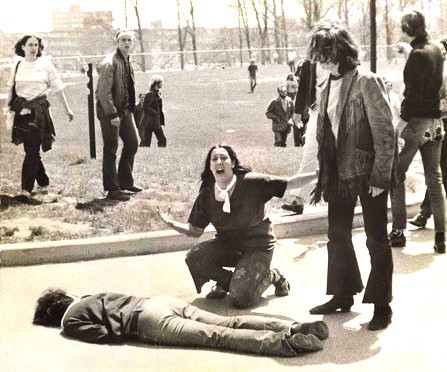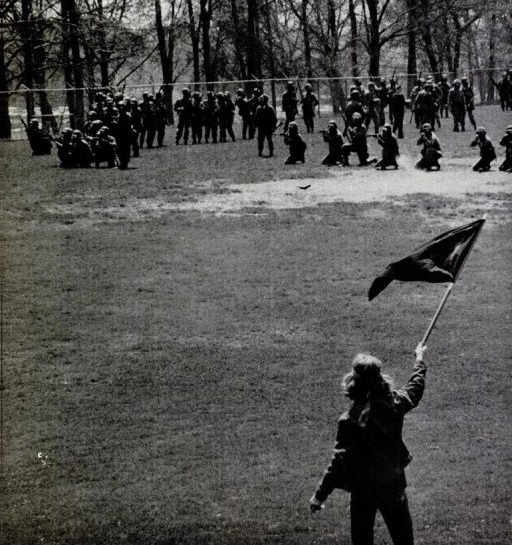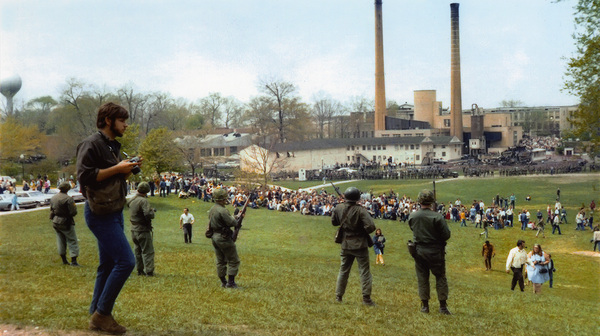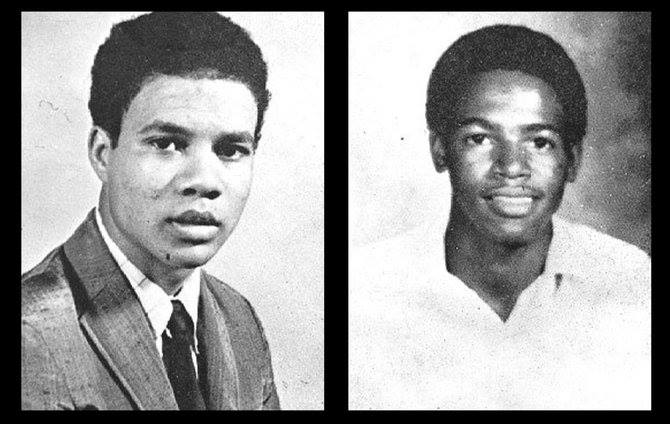The protest was held during lunchtime at OSU. Between 5% to 10% (1000 to 2000 of the 21,000-students then at the university) were attending the rally on the Commons or checking out the rally as they crossed the Commons on their way to or from lunch.
Others were milling around “Blanket Hill” watching what was going on.
At 12:24 pm 4 were dead; 9 were wounded.

Retouched photo, original by John Paul Filo, who was a journalism student at Kent State University in 1970, working for the Valley News-Dispatch at the time - Wikimedia
Tin soldiers and Nixon's coming
We're finally on our own
This summer I hear the drumming
Four dead in Ohio
- Four Dead In Ohio Music & Lyrics by Neil Young, Performed by Crosby, Stills, Nash, & Young
"It was shocking to see the armed, uniformed guardsmen suddenly all turn together and start to shoot a powerful 13-second barrage of 67 shots into our crowd of unarmed students. For a brief moment, I assumed they were firing blanks because there was no reason whatsoever to fire live ammunition…. As the bullets began to fly, my survival instinct caused me to make a quick dash behind an oak tree…. Just as I reached safety,...I felt a sharp pain in my right wrist when an M-1 bullet passed through my arm. ...I had to remain tucked behind that narrow, young tree which absorbed several bullets intended for me.”
~ Alan Canfora, BA ’72, MLS ’80, February 13, 1949–December 20, 2020 Alan is seen waving a flag across from the guardsmen in the top photo.
John Filo (left) with a camera in hand, overlooking the National Guardsmen and students on May 4, 1970. Photograph by James Coon, Kent State Shootings Photographs from Various Sources. Kent State University Libraries. Special Collections and Archives, http://omeka.library.kent.edu/special-collections/items/show/8721. Used with permission.
“ The bullets were supposed to be blanks. When I put the camera back to my eye, I noticed a particular guardsman pointing at me. I said, ‘I'll get a picture of this,’ and his rifle went off. And almost simultaneously, as his rifle went off, a halo of dust came off a sculpture next to me, and the bullet lodged in a tree.
"I dropped my camera in the realization that it was live ammunition. I don't know what gave me the combination of innocence and stupidity ... I started to flee – run down the hill and stopped myself. ‘Where are you going?’ I said to myself, ‘This is why you are here!’”
~ John Filo, Photojournalism ‘72, Pulitzer Prize 1971
Jackson State University
“When the order to ceasefire was given, Philip Lafayette Gibbs, 21, a junior pre-law major and father of an 18-month-old son, lay dead. Across the street, behind the line of police and highway patrolmen, James Earl Green, 17, was sprawled dead. Green, a senior at Jim Hill High School in Jackson, was walking home from work...when he stopped to watch….
Phillip Lafayette Gibbs (L) and James Earl Green (R). Source: Jackson Free Press – Zinn Education Project
Twelve other Jackson State students were struck by gunfire. The five-story dormitory was riddled by gunfire. FBI investigators estimated that more than 460 rounds struck the building, shattering every window facing the street on each floor. Investigators counted at least 160 bullet holes in the outer walls of the stairwell alone, bullet holes that can still be seen today.
“The injured students, many of whom lay bleeding on the ground…, were transported to University Hospital…. But the ambulances were not called until after the officers picked up their shell casings….”
~ African American Registry, https://aaregistry.org/story/killings-at-jackson-state-university/ on events occurring May 14, 1970
Official Rhetoric - Rinse & Repeat
“’That tragic day’ [May 4, 1970] followed Nixon’s announcement that the U.S. had invaded Cambodia and expanded the war, causing antiwar college students throughout the nation to go on strike. It was a time when the President called antiwar students ‘bums’ and Ohio’s Republican Governor James Rhodes...described [them] as ‘worse than brown shirts and the communist element and also night riders and vigilantes. They are the worst type of people that we harbor in America.’”
~ Murray Polner, original.antiwar.com, May 4, 2014, quoting Nixon and Rhodes
“This [protesting] is reminiscent of what happened in German universities in the 1930s. It’s unconscionable. It has to be stopped. It has to be condemned and condemned unequivocally.”
~ Benjamin Netanyahu, April 24, 2024
Words used to cut people down, take away their rights, words of alleged leaders. Worse still, words of peers, those who side with these leaders out of ignorance, or fear, or a false assumption that these leaders aren’t referring to them (or won’t be referring to them tomorrow.) These peers actually sent hate mail to parents of students killed at Kent State.
Must bullets follow?
State violence is shocking, frightening, and somehow still unexpected. Note the eyewitnesses’ shock when the bullets began in 1970, the assumption that it must be - was "supposed to be" - blanks or buckshot. This year, the shock of the assaulted professor at Emory University, April 26, 2024. It seems impossible that such things can be happening. But, they are. And, they have at least a 54-year precedent.
May, 1970 changed the course of the war in Viet Nam. But, bullets cannot be the only path for change. And, “change” that recurs isn’t systemic change, though personal change may culminate in systemic change if enough of us make it. Self-reliance may seem further away now than in 1970 during the one-million-strong push toward the back-to-the-land movement. More difficult today? Or, just different? More varied, creative, cooperative.
Resistance is still alive.








